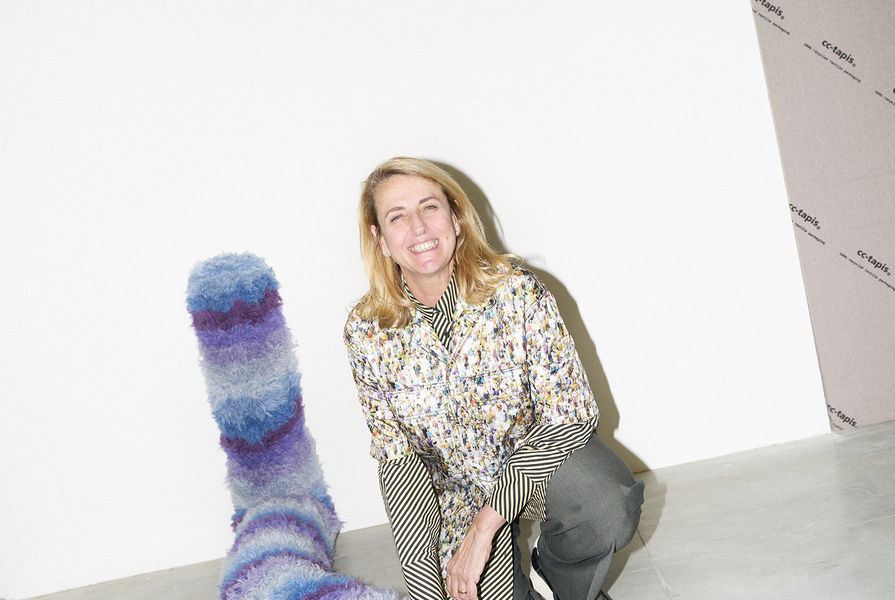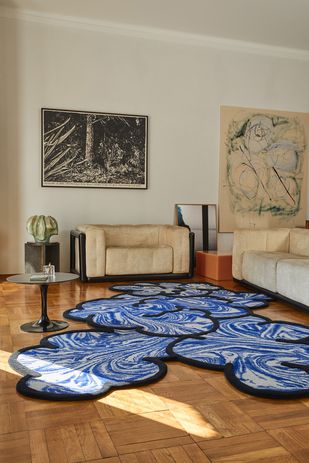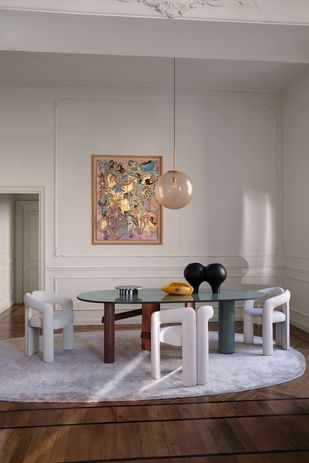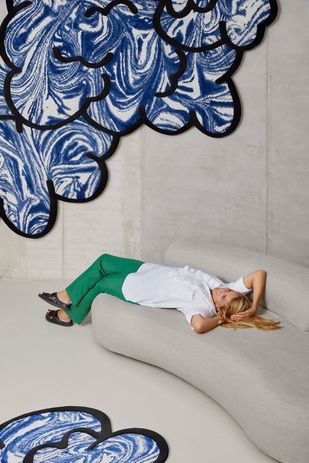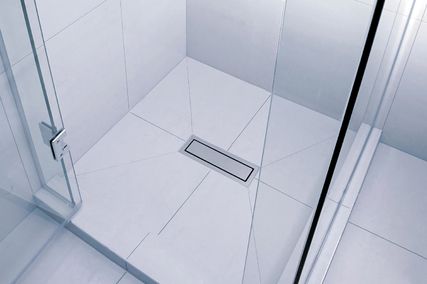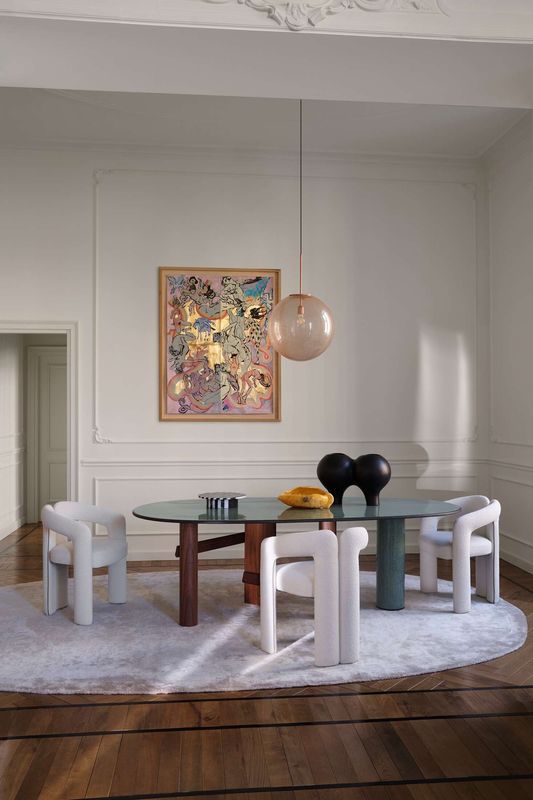“You always have a chance to change the rules” is a sentiment that seems to underpin Patricia Urquiola’s oeuvre, and it is the undertone of our chat at Mobilia’s Melbourne showroom during her fleeting visit to Australia in March 2024. Endlessly curious, Urquiola claims: “I don’t see answers, but rather I see questions.” The designer is a delightful conversationalist who indeed posits many questions – rhetorically or directly – during our interview.
Venus Power rug by Patricia Urquiola for CC-Tapis at Damir Doma’s private home. Photo by Carlotta Manaigo.
Image: Courtesy of Mobilia
Her presentation at Mobilia’s Design Circus event the next day (delivered to a captivated audience gathered at the NGV’s Great Hall) was equally exploratory. Fast-thinking, fast-talking, charismatic and open-minded, Urquiola managed to weave six ideas and four questions into one sentence, leaving listeners pleasantly bewildered and enlightened at once. You could almost hear the audience’s collective grey matter stretch as Urquiola spoke at lightning speed about nature, people, materials and innovation. Her ultimate point, I think, was that we’re all connected, and our collective mission is to evolve into a healthier society. It’s a mission she’s been on her whole career, using material and product design as vehicles, all the while supporting traditional craftspeople and bright young minds.
These messages fit the Design Circus bill, which for the past 10 years has brought international designers to Australia via an altruistic model (proceeds go to a nominated charity each year). Established in Madrid in 2010 and running in Perth from 2014, the 2024 Mobilia Design Circus event was the first in Melbourne, with $35,000 in proceeds donated to Toybox Australia.
Urquiola was born in Oviedo, Spain, in 1961, and founded her Milan-based studio together with her partner, Alberto Zontone, in 2001. Her trailblazing architecture and design career is defined by her pursuit of originality, commitment to human-centric solutions, and passion for craft and material. The studio traverses industrial product design, architecture, art direction and strategy consulting, all guided by a common goal to build empathetic connections with end-users. Urquiola’s work is research-driven and future-focused, blending technology with environmental and social awareness.
Cassina Dudet chair by Patricia Urquiola.
Image: Courtesy of Mobilia
Fascinated by surfaces, Urquiola says that with all her clients, she is leading discussions about disassembly, recycling and reuse. During her Design Circus address, she referenced her project with Glas Italia, which involved the layering of waste material to create a new kind of glass with an opaque, imperfect yet sensual surface. She also spoke about a new biomaterial that she is delevoping with Cimento, which can be composed from almost any raw material. She believes that “products are in the middle of the process”; without material research and waste-management strategies, the product design process would be incomplete.
She told me that “in this moment, I’m only working with people who are doing research into more sustainable production – who are searching for a new and different beauty that is born or regenerated another way.” One example is her Moncloud Sofa for Cassina (available at Mobilia), which uses recycled PET fibre padding (I can attest to its comfort; Urquiola and I sat on the Moncloud for our interview). Urquiola has held the position of creative director at Cassina since 2015 and explains that the production process is “going slower in some ways by getting into the process of the materials … This year, we’re not doing anything more – not a new couch, but instead, the same one in a new typology. Each year or two we evolve, renovating other typologies but with a new sustainable process or material.”
Patricia Urquiola for CC-Tapis.
Image: Claudia Zalla
For CC-Tapis – a socially-minded Italian rug brand that celebrates traditional Nepalese weaving traditions – Urquiola tells me about a new product composed from 50 percent new wool and 50 percent leftover or regenerated material. She’s excited by the new ways this technique can involve craftspeople and develop different understandings of wool. You can read this process directly in the final rug designs, which clearly reveal the new versus recycled materials.
When asked how brands can improve their sustainable practices, Urquiola says: “To give advice is always so difficult. But if you do something with care, then people take more care with the product … It’s time to shift from aesthetic choices to empathetic choices. The latter lasts longer.”
Urquiola’s influence in the design industry extends to Moroso, Kettal, Louis Vuitton, Kvadrat, Mutina and more. She has also created architectural works like the il Sereno Hotel in Como and the Room Mate Giulia Hotel in Milan, as well as innovative product designs for BMW showrooms and installations for Missoni.
Cassina Hayama sideboard by Patricia Urquiola.
Image: Courtesy of Mobilia
Urquiola is grateful for her extensive travels to both urban and natural destinations. During her Design Circus talk, Urquiola told the audience: “You’re looking to me, but I’m looking to you.” She has plenty of positive things to say about Australia after visits to Sydney, Melbourne and Uluru. “I try to be sensitive to everything … In Australia, you have so many beautiful trees – these are more important than urban planning, design, etc. Nature has an incredible presence. At the end of the day, our life is about how to create a formula that connects nature, including the plants, water, animals and all human society.”
She goes on to say: “Here, I see a lot of women taking care of communication, art and museums – when I see that, I think that something is working.” She says that an open mind, belief in the process and transmission of these ideas are essential to the evolution of creative individuals and cultures.
“I think there are lots of possibilities here,” she says about the Australian design market. “In Europe, I wish we were able to change, but because of our long history, it is difficult. Here in Australia, you have perspectives from many different cultures, and you have a great distance. This creates potential. You are a young society … We must make young people participate. It’s not only my generation that will change things – it’s the relationship between my generation and the next.”

